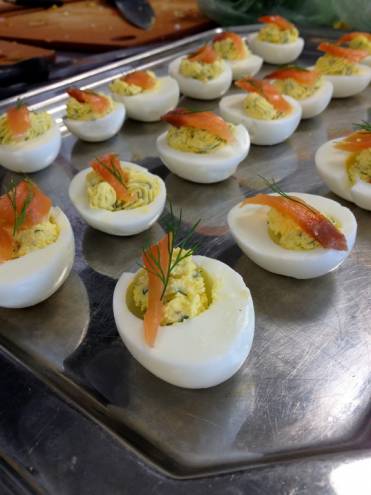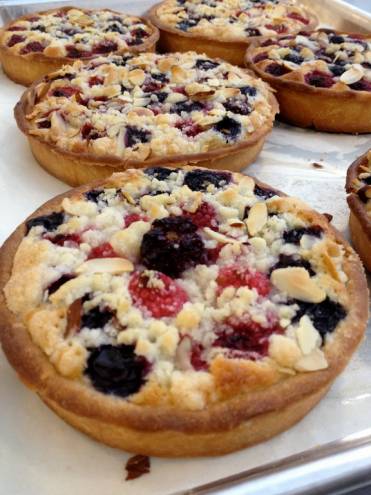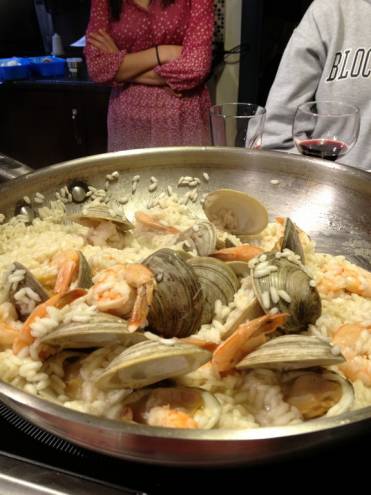Well, if we’re being completely honest here, it’s not that I can’t cook – it’s that I really, really don’t want to. I do technically know how a stove works, and have successfully cooked tens of meals on mine. I can bake with the best of them, but my feeling is that if I’m going to spend an hour in the kitchen, I damn well better have something pretty to show off as a result. There’s just nothing glamorous about chicken and Brussels sprouts.
My aversion to cooking is such that I once brought lunch to work that I had made at home, and this conversation ensued:
Coworker: What are you eating?
Me: A sandwich. Obviously.
Coworker: Yeah, but who made it?
Me: I did.
Coworker: You did? But how can you eat food that wasn’t brought to you by a waiter?
But really, how can you blame me?
Providence is a delicious city, already populated by countless people with real culinary training, all waiting, butcher knives in hand, to make me dinner. But soon after that conversation, I started noticing a trend. Many of those same restaurants where I had spent night after night (and paycheck after paycheck) offer cooking classes. My final objection – that what chefs cook me is vastly preferable to what I can muster at home – had an answer. I set off to learn how to cook.
Step One: Feeding My Friends If I was going to go to the trouble of learning to cook, I was going to start in a way that would provide maximum benefit to my life – namely, being able to cook small, delicious things to impress my friends at a cocktail party. My first stop was Johnson and Wales. While they train high quality chefs over the course of many years of study, those professor/chefs also teach a huge variety of Chef’s Choice Cooking Classes. I chose to spend one dreary Saturday morning at JWU’s Harborside Campus learning Modern American Appetizers, an overview of how to make 10 surprisingly simple, gourmet small bites.
If I was going to go to the trouble of learning to cook, I was going to start in a way that would provide maximum benefit to my life – namely, being able to cook small, delicious things to impress my friends at a cocktail party. My first stop was Johnson and Wales. While they train high quality chefs over the course of many years of study, those professor/chefs also teach a huge variety of Chef’s Choice Cooking Classes. I chose to spend one dreary Saturday morning at JWU’s Harborside Campus learning Modern American Appetizers, an overview of how to make 10 surprisingly simple, gourmet small bites.
Chef Peter Cooper began the lesson with a lecture, covering his background in cooking (he owned a restaurant for 20 years before committing full time to teaching at JWU), basic knife and kitchen techniques, and how the class would run. There were eight teams of three people each, and each was assigned a JWU student volunteer to help us find ingredients and (somewhat embarrassingly) show us the full extent of how much we don’t know about cooking. One saved the cranberries I was reducing (read: burning) from total destruction.
Of the ten choices, my team – a mother/daughter duo on a birthday weekend in Providence and me – picked Oysters on the Half Shell with Apple Mignonette, and Baked Brie with Cranberry Compote and Herb-Candied Pecans. Others had choices like Deviled Eggs with Smoked Salmon, Dill and Black Sea Salt; Spiced Corn Cakes with Avocado Lime Salsa; Crostini of Beef Carpaccio with Red Onion Jam and Blue Cheese.
JWU isn’t messing around with the lessons it offers – but though the food was complex, it was presented to us in a way that was easy to follow, simple to cook and, as I learned later, nicely recreated at home. After our food was done, I walked around the room to talk to other students as they were finishing their dishes. Two were there celebrating a birthday; one was looking to spice up his traditional game day recipes in preparation for football season. They all had different levels of cooking skill, but didn’t have a problem executing their recipes.
After we were done cooking, we brought our dishes to the dining room, with an expansive view of the harbor. All of the students had bonded through the three hours, and we all tasted and complimented each others’ cooking. I, at least, left feeling like I could easily cook something as daunting as Beef Carpaccio at home, and more, that I actually wanted to.
Step Two: Feeding My Ego Because I had conquered the unknown, I felt like I was ready for a treat – literally and figuratively. A baking class isn’t precisely a cooking class, but I love baking too much to have resisted the allure of All Things Tarts at The French Tarte, a patisserie in Hope Artiste Village in Pawtucket. The Francophilic bakery, run by Cordon Bleu-trained Susan VandenBerg, sells seasonal baked goods to order. Susan (who for four years was the pastry chef at Gracie’s) also offers twice-weekly classes in madelines, puff pastry, brioche and other French treats.
Because I had conquered the unknown, I felt like I was ready for a treat – literally and figuratively. A baking class isn’t precisely a cooking class, but I love baking too much to have resisted the allure of All Things Tarts at The French Tarte, a patisserie in Hope Artiste Village in Pawtucket. The Francophilic bakery, run by Cordon Bleu-trained Susan VandenBerg, sells seasonal baked goods to order. Susan (who for four years was the pastry chef at Gracie’s) also offers twice-weekly classes in madelines, puff pastry, brioche and other French treats.
While I’m an accomplished baker, I tend to stay away from anything involving making my own dough. I fall on the cakes, cupcakes and cookies side rather than what I had already decided was the rolling, kneading, rising, flour-everywhere, rolling-pin-thrown-through-the-window side. This class seemed like the perfect way to complicate a subject in which I already had a solid foundation.
It turns out that making and rolling out dough is surprisingly easy. At least, it is if you have someone as practiced as Susan teaching you. All it takes is combining a handful of ingredients, crumbing them together with your hands, letting the dough chill, and then working quickly to roll it flat and lay it in the tart pan. We worked in three teams of two people in her charming kitchen, and in a couple of hours learned how to make two doughs, and all kinds of fillings. While we focused on sweet tarts – fresh berries, almond cream, lemon curd, blackberry mascarpone, chocolate ganache – the same doughs can easily be applied to savory foods.
I was so energized by the simplicity and elegance of the tarts that I immediately went out and bought a French rolling pin, pie weights and two sizes of tart pans. Later that week, I did something practically unheard of: I made dinner. In my house. For other people. On the menu was something that combined Susan’s impeccable technique with Chef Cooper’s philosophy of letting a few high quality ingredients do all the work: a caramelized onion tart with gruyere and fresh thyme. It was simple to make, but looked and tasted restaurant quality.
Step Three: Feeding Myself I had successfully learned how to cook for a party, but that was something I had already kind of wanted to do. (After all, if I’m going to go to the trouble of cooking a bunch of stuff, you bet your ass I’m going to find a way to get praised for it.) It was time for a real challenge, the one I didn’t think I’d ever truly conquer: learning to cook for myself. I headed to North Providence for a lesson in making risotto from Professor Chef.
I had successfully learned how to cook for a party, but that was something I had already kind of wanted to do. (After all, if I’m going to go to the trouble of cooking a bunch of stuff, you bet your ass I’m going to find a way to get praised for it.) It was time for a real challenge, the one I didn’t think I’d ever truly conquer: learning to cook for myself. I headed to North Providence for a lesson in making risotto from Professor Chef.
Professor Chef is Phil Griffin and Malinda Coletta, a husband and wife duo who teach out of their own gourmet kitchen. Phil is a former JWU professor and chef at Providence restaurants like Adesso; Malinda has a bachelors degree in Home Economics. Six students gathered around their kitchen island for a lesson in good home cooking practices: they gave us tips on where to buy the cheapest, best quality ingredients; how to minimize kitchen waste; how to make our own very simple and high quality stock for our home cooking. While the other lessons had been more hands-on, this one was more of a demonstration – in between Phil and Malinda’s comedy act, they showed us how to make three different kind of risotto, giving step by step instruction, involving us one at a time in the cooking process.
We asked questions while enjoying Truffled Porcini Risotto, Beet and Goat Cheese Risotto and Seafood Risotto. We had all individually made risotto before, but vowed to never do it again, after an hour’s worth of effort ended up with a soggy, gluey mess. Phil and Malinda so effectively demystified the process, showing us how to make exceptional risotto that only needed to cook for 20 or so minutes, that I made one the next day. And later on that week. As I cooked, I started a bag of vegetable scraps to make my own stock. A friend saw it in my freezer and said, “you’re cooking, you’re cleaning up after yourself, you’re making your own stock? Who are you?” Apparently, no longer a kitchen-phobe.
Comments
No comments on this item Please log in to comment by clicking here